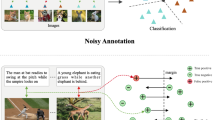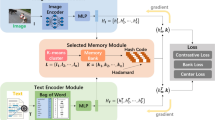Abstract
Relevance feedback (RF) has long been an important approach for multi-media retrieval because of the semantic gap in image content, where SVM based methods are widely applied to RF of content-based image retrieval. However, RF based on SVM still has some limitations: (1) the high dimension of image features always make the RF time-consuming; (2) the model of SVM is not discriminative, because labels of image features are not sufficiently exploited. To solve above problems, we proposed robust discriminative extreme learning machine (RDELM) in this paper. RDELM involved both robust within-class and between-class scatter matrices to enhance the discrimination capacity of ELM for RF. Furthermore, an angle criterion dimensionality reduction method is utilized to extract the discriminative information for RDELM. Experimental results on four benchmark datasets (Corel-1K, Corel-5K, Corel-10K and MSRC) illustrate that our proposed RF method in this paper achieves better performance than several state-of-the-art methods.









Similar content being viewed by others
References
Akusok, A., Miche, Y., Karhunen, J., et al. (2015). Arbitrary category classification of websites based on image content. IEEE on Computational Intelligence Magazine, 10(2), 30–41.
Anitha, S., & Rinesh, S. (2013). Semi-supervised biased maximum margin analysis for interactive image retrieval. Research Journal of Computer Systems Engineering, 4, 532–536.
Cao, J., Huang, W., Zhao, T., Wang, J., & Wang, R. (2015a). An enhance excavation equipments classification algorithm based on acoustic spectrum dynamic feature. Multidimensional Systems and Signal Processing. doi:10.1007/s11045-015-0374-z.
Cao, J., & Lin, Z. (2015). Extreme learning machine on high dimensional and large data applications: A survey. Mathematical Problems in Engineering. doi:10.1155/2015/103796.
Cao, J., Lin, Z., Huang, G.-B., & Liu, N. (2012). Voting based extreme learning machine. Information Sciences, 185(1), 66–77.
Cao, J., Zhao, Y., Lai, X., Ong, M., Yin, C., Koh, Z., et al. (2015b). Landmark recognition with sparse representation classification and extreme learning machine. Journal of The Franklin Institute, 352(10), 4528–4545.
Deng, W., Zheng, Q., & Chen, L. (2009). Regularized extreme learning machine. In Computational intelligence and data mining, CIDM’09 (pp. 389–395).
Feng, L., Liu, S., Xiao, Y., et al. (2015). A novel CBIR system with WLLTSA and ULRGA. Neurocomputing, 147, 509–522.
He, X. (2004). Incremental semi-supervised subspace learning for image retrieval. In Proceedings of the 12th annual ACM international conference on multimedia (pp. 2–8).
He, X., & Niyogi, P. (2003). Locality preserving projections. In Advances in neural information processing systems 16. Vancouver, Canada.
He, Q., Jin, X., Du, C., et al. (2014). Clustering in extreme learning machine feature space. Neurocomputing, 128, 88–95.
Hoi, S. C. H., Jin, R., Zhu, J., et al. (2008) Semi-supervised SVM batch mode active learning for image retrieval. In IEEE Conference on Computer Vision and Pattern Recognition (pp. 1–7).
Hoi, S. C. H., & Lyu, M. R. (2005). A semi-supervised active learning framework for image retrieval. Computer Vision and Pattern Recognition, 2, 302–309.
Horata, P., Chiewchanwattana, S., & Sunat, K. (2013). Robust extreme learning machine. Neurocomputing, 102, 31–44.
Huang, G.-B. (2015). What are extreme learning machines? Filling the gap between Frank Rosenblatt’s Dream and John von Neumann’s Puzzle. Cognitive Computation, 7, 263–278.
Huang, G., & Chen, L. (2007). Convex incremental extreme learning machine. Neurocomputing, 70(16–18), 3056–3062.
Huang, G., Chen, L., & Siew, C.-K. (2006). Universal approximation using incremental constructive feedforward networks with random hidden nodes. IEEE Transactions on Neural Networks, 17(4), 879–892.
Huang, G. B., Zhou, H., Ding, X., et al. (2012). Extreme learning machine for regression and multiclass classification. IEEE Transactions on Systems, Man, and Cybernetics, Part B: Cybernetics, 42(2), 513–529.
Iosifidis, A., Tefas, A., & Pitas, I. (2013). Minimum class variance extreme learning machine for human action recognition. IEEE Transactions on Circuits and Systems for Video Technology, 23(11), 1968–1979.
Iosifidis, A., Tefas, A., & Pitas, I. (2014). Regularized extreme learning machine for multi-view semi-supervised action recognition. Neurocomputing, 145, 250–262.
Jin, Y., Cao, J., Wang, Y., et al. (2015). Ensemble based extreme learning machine for cross-modality face matching. Multimedia Tools and Applications, 1–16.
Kundu, M. K., Chowdhury, M., & Bulò, S. R. (2015). A graph-based relevance feedback mechanism in content-based image retrieval. Knowledge-Based Systems, 73, 254–264.
Liu, S., Feng, L., & Qiao, H. (2015). Scatter Balance: An angle-based supervised dimensionality reduction. IEEE Transactions on Neural Networks and Learning Systems, 26(2), 277–289.
Liu, S., Feng, L., Xiao, Y., et al. (2014). Robust activation function and its application: Semi-supervised kernel extreme learning method. Neurocomputing, 144, 318–328.
Liu, G. H., Li, Z. Y., Zhang, L., et al. (2011). Image retrieval based on micro-structure descriptor. Pattern Recognition, 44(9), 2123–2133.
Lu, K., Zhao, J., & Cai, D. (2006). An algorithm for semi-supervised learning in image retrieval. Pattern Recogition, 39(4), 717–720.
Minhas, R., Baradarani, A., Seifzadeh, S., et al. (2010). Human action recognition using extreme learning machine based on visual vocabularies. Neurocomputing, 73(10), 1906–1917.
Mohammed, A. A., Minhas, R., Wu, Q. M. J., et al. (2011). Human face recognition based on multidimensional PCA and extreme learning machine. Pattern Recognition, 44(10), 2588–2597.
Murala, S., & Wu, Q. M. (2014). Local mesh patterns versus local binary patterns: Biomedical image indexing and retrieval. IEEE Journal of Biomedical and Health Informatics, 18(3), 929–938.
Ojala, T., Pietikainen, M., & Maenpaa, T. (2002). Multiresolution gray-scale and rotation invariant texture classification with local binary patterns. IEEE Transactions on Pattern Analysis and Machine Intelligence, 24(7), 971–987.
Swain, M. J., & Ballard, D. H. (1991). Color indexing. International Journal of Computer Vision, 7(1), 11–32.
Tan, X., & Triggs, B. (2007). Enhanced local texture feature sets for face recognition under difficult lighting conditions. In Analysis and modeling of faces and gestures (pp. 168–182). Berlin: Springer.
Tang, X., & Han, M. (2009). Partial Lanczos extreme learning machine for single-output regression problems. Neurocomputing, 72(13–15), 3066–3076.
Tang, X., & Han, M. (2009). Partial Lanczos extreme learning machine for single-output regression problems. Neurocomputing, 72(13–15), 3066–3076.
Zhang, P., & Yang, Z. (2015). A robust AdaBoost.RT based ensemble extreme learning machine. Mathematical Problems in Engineering, 2015, 260970. http://www.hindawi.com/journals/mpe/2015/260970/cta/.
Zhang, K., & Luo, M. (2015). Outlier-robust extreme learning machine for regression problems. Neurocomputing, 151, 1519–1527.
Zhang, S., Yang, M., Cour, T., et al. (2015). Query specific rank fusion for image retrieval. IEEE Transactions on Pattern Analysis and Machine Intelligence, 37(4), 803–815.
Author information
Authors and Affiliations
Corresponding author
Additional information
This work was supported by National Natural Science Foundation of P. R. China (61173163, 61370200) and China Postdoctoral Science Foundation (ZX20150629).
Rights and permissions
About this article
Cite this article
Liu, S., Feng, L., Liu, Y. et al. Robust discriminative extreme learning machine for relevance feedback in image retrieval. Multidim Syst Sign Process 28, 1071–1089 (2017). https://doi.org/10.1007/s11045-016-0386-3
Received:
Revised:
Accepted:
Published:
Issue Date:
DOI: https://doi.org/10.1007/s11045-016-0386-3




